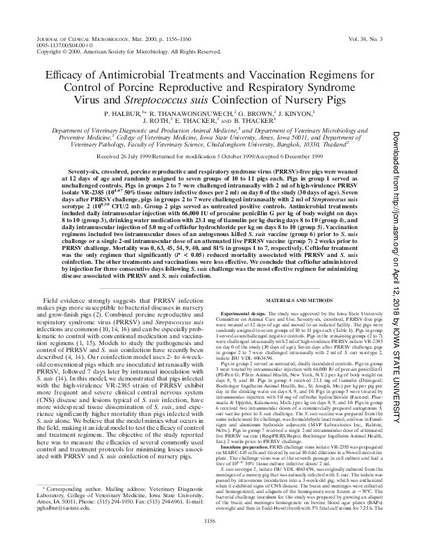
Seventy-six, crossbred, porcine reproductive and respiratory syndrome virus (PRRSV)-free pigs were weaned at 12 days of age and randomly assigned to seven groups of 10 to 11 pigs each. Pigs in group 1 served as unchallenged controls. Pigs in groups 2 to 7 were challenged intranasally with 2 ml of high-virulence PRRSV isolate VR-2385 (104.47 50% tissue culture infective doses per 2 ml) on day 0 of the study (30 days of age). Seven days after PRRSV challenge, pigs in groups 2 to 7 were challenged intranasally with 2 ml of Streptococcus suis serotype 2 (108.30 CFU/2 ml). Group 2 pigs served as untreated positive controls. Antimicrobial treatments included daily intramuscular injection with 66,000 IU of procaine penicillin G per kg of body weight on days 8 to 10 (group 3), drinking water medication with 23.1 mg of tiamulin per kg during days 8 to 10 (group 4), and daily intramuscular injection of 5.0 mg of ceftiofur hydrochloride per kg on days 8 to 10 (group 5). Vaccination regimens included two intramuscular doses of an autogenous killedS. suis vaccine (group 6) prior to S. suischallenge or a single 2-ml intramuscular dose of an attenuated live PRRSV vaccine (group 7) 2 weeks prior to PRRSV challenge. Mortality was 0, 63, 45, 54, 9, 40, and 81% in groups 1 to 7, respectively. Ceftiofur treatment was the only regimen that significantly (P < 0.05) reduced mortality associated with PRRSV and S. suis coinfection. The other treatments and vaccinations were less effective. We conclude that ceftiofur administered by injection for three consecutive days following S. suis challenge was the most effective regimen for minimizing disease associated with PRRSV and S. suiscoinfection.
Available at: http://works.bepress.com/james_roth/74/

This article is published as Halbur, P., R. Thanawongnuwech, G. Brown, J. Kinyon, J. Roth, E. Thacker, and B. Thacker. "Efficacy of antimicrobial treatments and vaccination regimens for control of porcine reproductive and respiratory syndrome virus and Streptococcus suis coinfection of nursery pigs." Journal of clinical microbiology 38, no. 3 (2000): 1156-1160. Posted with permission.